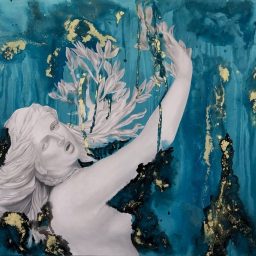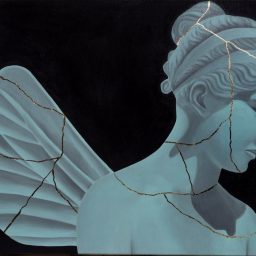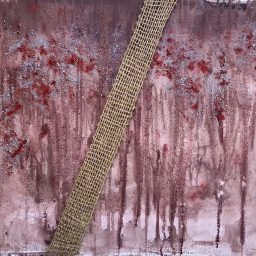Lives and works in Rome
I looked at women, women who wait, women who observe, women who know and change the world. It all started with the study of women's body language, legs portrayed in positions that express intimate and personal states of mind. I imagine these scenes as fragments in which time no longer exists, or is suspended for an instant in a dreamlike memory.Over the years, this study has led me to change my point of view: I have looked at nature as a woman who resists, generates life, protects, punishes and forgives. I was inspired by historical and mythological icons to search those fictional lives for morals different from the classical and canonical ones, turning them feminine and analyzing them.In the myth of Cupid and Psyche, it is the will to knowledge and courage that moves Psyche, who with strength and independence will face very difficult trials. This long journey will not only lead her to find her beloved but, even more, herself, until she reaches parity with Love at the moment when she is transformed into a Goddess.I have been reflecting on how many women today are still struggling and do not find the strength to fight back, starting over from themselves.Among the various myths from which I could have drawn inspiration to deal with the topic, one in particular struck me.I reread in a contemporary key the story of "Apollo and Daphne" from Ovid's The Metamorphoses. Daphne is a young nymph, a woman who has taken a vow of chastity to Diana, but behind this vow are not religious messages, but rather a need for emancipation from a reality of men, violence and violation of one's freedom.
In fact, Cupid, envious, makes Apollo fall in love with Daphne, knowing that he would not be reciprocated, which makes the nymph a victim of this capricious quarrel between gods.
Men who play with love by reducing it to a body to possess, to an obsession that does not respect the woman's freedom. Finally, in the metamorphic act of Daphne, when exhausted she invokes her mother Gaea, we are faced with the martyrdom of a woman who becomes a symbol of resistance struggle.
The laurel plant, which, in the myth, Apollo will make an evergreen plant, was for the ancients the representation of perpetual life, as immortal as the message of resistance that Daphne, unknowingly, still conveys today."I represent the moment as if it were the fragment of a memory of which you can focus only a small detail, a piece, that can tell an entire story. The gesture of a woman who is simultaneously wife and lover, mother and child, a multifaceted woman to look like through a kaleidoscope. The title of the works indicates a possible path and does not want to be an obligatory path towards an interpretation, but leaves to those who observe the freedom to imagine according to their own suggestion. I use, as if they were sketches, photographs taken by me, but also images borrowed from the media, then focusing only on the detail that interests me."
Gianluca Marziani for the catalogue "The Laws of Desire"
..."The artist turns his eye around the female body. He sets on the canvas individual details within neutral but welcoming contexts, letting float the various physicalities in the abstract places that show the intimate consciousness of the private space. We see women in the field through partial shots that hide their face, giving beauty the impact of an evocative archetype. Legs, bandage dresses, sexy high-heeled shoes, posturecalibrate where every actionresponses to a reegorical analysis of the iconographic eros. Everything is played on the fragment, on the aptitudes of the body that is being painted. A figurative journey on the subtle diaphragm between photographic realism and pictorial liquidity. A project where the ghostly softness of the bodies contrasts with the precision of the accessories and feet, rendered by the artist a magnetic catalyst that distributes energy throughout the entire project." ...
Giuseppe Di Bella for the magazine Con-fine
..."You can not escape the beauty of the eyes they observe, eyes that in that range of veiled perceptions, eyes that with that ability to grasp nuances and nuanced psychological conditions can only belong to a female artist being: at least the last twenty years are dotted with names and careers of painters that show us the powers that arise from the tensions of the specificity of the Art-woman. And so without screaming, through a clear catalog even Consuelo Mura illustrates the path that finds mediation as a form of current strategy and disynthesis between antinomies to suggest the minimum moments and even overflowing with anxiety and pathos of the private. The hybrid step, however, with which we approach the real is a way by which to evaluate the limitations or the missed possibilities of the painting that precedes us and focus it on the vacuum slide in a theoretical and concrete sense. The sense of detachment is transformed to stage the solitude to which our age seems doomed, private solitude, of women inhabitants of empty houses, almost entirely without presences who can enjoy the opulence of their offer. The space on which the figures are glued is a void made by subtraction, for emptying or for deletion as on Photoshop, a mute background and open to any definition of silhouette. That ability to investigate art in its unconventional artifice brings an endless series of illustrious names that the artist has introduced to disguise the tradition or classic of his works in a lived life in which the woman who takes off or slips the celestial cleavage shoe has the same value as a bather at the sea taken while she is intent on lifting the undercoat. A voyeurism granted only to art and in this case to genre art." ...
Marina Marinelli for the catalogue "of Love and Psyche and other bodies"
..."The models inspired become a very personal matter in making the Roman painter, who transforms the mitopoietic figures into apparitions of everyday life. With its unmistakable incardine style, the anatomy of the bodies in a static, abstract and timeless dimension, while focusing the framing on a detail extrapolated from a general context. The presences that populate the real world and that of the myth talk in a subtle dialectical game and references. The Wall starts from the representation of "other bodies"painted in black and white, with an almost marbled consistency and where the chromatic ignition is reserved only for special accessories, such as shoes and clothes, evocations of a female world with high seductive potential. Following an ideal path and suited to her pictorial research the Roman painter arrives at the re-enactment of the actual statue, but subverting the monochrome of marble in favor of color, to which she entrusts new expressive faculties and even playful accents." ......"Consuelo Mura's painting is a contemplative painting that looks at the human figure as a silent and posing subject, a metaphor for the complex dynamics of reality and the chain of its possible meanings. The traditional perspective box is transformed into a conceptual container, in which an unsuspendless time is consumed: the lag of suspension and waiting. This interval suggests the idea of a private environment and a condition of being dominated by expectation, desire and remembrance. The split of an instant is painted of the soul, in the burst of fatally subjective emotions. The loneliness of the bodies is simply apparent. In fact, they assume the existence of another by themselves, of a third, as also demonstrated by the titles of the works in the form of phrases addressed to an invisible anorem interlocutor. In the indefinability of space-time the "other bodies" occupy the canvas stale, sitting or lying down, they make themselves look and imagine in their anonymity. Psyche and Venus, on the other hand, present themselves without infsreation, with their faces uncovered, finally proposing the unveiling of identity and role. The gods as archetypes, patterns of behavior and personality, fulfill the function of belonging to the collective. To the world of those who paint and those who look at the work of art. To the world of all souls who face the difficult path of purification and redemption through love. With an evocative and sensitive language, with refined and impeccable shots in the definition of forms, Consuelo Mura proposes a contamination between the physical world and the symbolic world without contradictions and without continuity. An opportunity that obliges us to listen and an invitation to prolong the life of the work of art in our very existence. "...
Consuelo Mura:
"Every gesture of the geisha is measured, the food that leads to the mouth must not touch her lips, the hair is gathered in a perfect hairstyle that requires very long preparation, the kimono and the very high hooves flip-flops force her in very small steps. An educated, elegant woman, a perfect woman with the sole task of pleasing and satisfying the man. I turn west and see a woman in a corset who doesn't let her breathe until she faints. In every latitude it was wanted a woman who could not move, run, sweat, make mistakes, in short be free as a man. Even in the dancers we look fascinated by the beauty of the foot, of its ankle neck laced in the laces of the pointy shoe, but inside there is often a deformed and suffering foot, forced into an unnatural position. And here I can not but think of the "lotus flowers" the famous feet of the noble Chinese women deformed already at the age of 5-6 years and locked in tiny shoes, with serious suffering." (C.M.)
Events at Rome Art Week
Free access
2023
Free access
2022
Free access
Vernissage Monday 24 Oct 2022 | 17:00-21:00
Free access
2021
Free access
Vernissage Monday 25 Oct 2021 | 18:30-21:00
Free access
2020
Free access
Free access
2019
Free access
Free access














